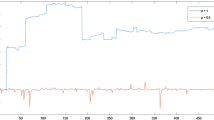Abstract
Autoregressive models are commonly employed to analyze empirical time series. In practice, however, any autoregressive model will only be an approximation to reality and in order to achieve a reasonable approximation and allow for full generality the order of the autoregression, h say, must be allowed to go to infinity with T, the sample size. Although results are available on the estimation of autoregressive models when h increases indefinitely with T such results are usually predicated on assumptions that exclude (1) non-invertible processes and (2) fractionally integrated processes. In this paper we will investigate the consequences of fitting long autoregressions under regularity conditions that allow for these two situations and where an infinite autoregressive representation of the process need not exist. Uniform convergence rates for the sample autocovariances are derived and corresponding convergence rates for the estimates of AR(h) approximations are established. A central limit theorem for the coefficient estimates is also obtained. An extension of a result on the predictive optimality of AIC to fractional and non-invertible processes is obtained.
Similar content being viewed by others
References
Akaike H. (1969). Fitting autoregressive models for prediction. Annals of Institute of Statistical Mathematics. 21, 243–247
Akaike H. (1970). Statistical predictor identification. Annals of Institute of Statistical Mathematics. 22, 203–217
Anderson T.W. (1971). The statistical analysis of time series. New York, Wiley
Baillie R.T. (1996). Long memory processes and fractional integration in econometrics. Journal of Econometrics. 73, 5–59
Baxter G. (1962). An asymptotic result for the finite predictor. Mathematica Scandinavica. 10, 137–144
Beran J. (1992). Statistical methods for data with long-range dependence. Statistical Science. 7, 404–427
Beran J. (1994). Statistics for long memory processes. New York, Chapman and Hall
Beran J., Bhansali R.J., Ocker D. (1998). On unified model selection for stationary and nonstationary short- and long-memory autoregressive processes. Biometrika. 85, 921–934
Burg J. (1968). A new analysis technique for time series data. Technical report, Advanced Study Institute on Signal Processing, N.A.T.O., Enschede, Netherlands
Davies R.B., Harte D.S. (1987). Tests for hurst effect. Biometrika. 74, 95–101
Durbin J. (1960). The fitting of time series models. Review of International Statistical Institute. 28, 233–244
Granger C.W.J., Joyeux R. (1980). An introduction to long-memory time series models and fractional differencing. Journal of Time Series Analysis. 1, 15–29
Grey H.L., Zhang N.-F., Woodward W.A. (1989). On generalized fractional processes. Journal of Time Series Analysis. 10, 233–257
Grose S., Poskitt D.S. (2005). Empirical evidence on nonstandard autogregressive approximations. Working Paper, Monash University
Hannan E.J., Deistler M. (1988). The statistical theory of linear systems. New York, Wiley
Hannan E.J., Quinn B.G. (1979). The determination of the order of an autoregression. Journal of Royal Statistical Society, B 41, 190–195
Hosking J.R.M. (1980). Fractional differencing. Biometrika. 68, 165–176
Hosking J.R.M. (1996). Asymptotic distributions of the sample mean, autocovariances, and autocorrelations of long memory time series. Journal of Econometrics. 73, 261–284
Kolmorgorov A.N. (1941). Interpolation und extrapolation von stationaren zufalligen folgen.Bulletin Academy Science U. S. S. R., Mathematics Series. 5, 3–14
Levinson N. (1947). The Wiener RMS (root mean square) error criterion in filter design and prediction. Journal of Mathematical Physics. 25, 261–278
Lysne D., Tjøstheim D. (1987). Loss of spectral peaks in autoregressive spectral estimation. Biometrika. 74, 200–206
Mallows C.L. (1973). Some comments on C p . Technometrics 15, 661–675
Parzen E. (1974). Some recent advances in time series modelling. IEEE Transactions on Automatic Control. AC-19, 723–730
Paulsen J., Tjøstheim D. (1985). On the estimation of residual variance and order in autoregressive time series. Journal of the Royal Statistical Society. B-47, 216–228
Poskitt D.S. (2000). Strongly consistent determination of cointegrating rank via canonical correlations. Journal of Business and Economic Statistics. 18, 71–90
Schwarz G. (1978). Estimating the dimension of a model. Annals of Statistics. 6, 461–464
Shibata R. (1980). Asymptotically efficient selection of the order of the model for estimating parameters of a linear process. Annals of Statistics. 8, 147–164
Szegö, G. (1939). Orthogonal polynomials. American Mathematical Society Colloquium Publication.
Tjøstheim D., Paulsen J. (1983). Bias of some commonly-used time series estimators. Biometrika. 70, 389–400
Wand M.P., Jones M.C. (1995). Kernel smoothing. London, Chapman and Hall
Wold H.(1938). The analysis of stationary time series (2nd ed). Uppsala, Almquist and Wicksell
Yule G.U. (1921). On the time correlation problem. Journal of the Royal Statistical Society, 84, 497–510
Author information
Authors and Affiliations
Corresponding author
About this article
Cite this article
Poskitt, D.S. Autoregressive approximation in nonstandard situations: the fractionally integrated and non-invertible cases. AISM 59, 697–725 (2007). https://doi.org/10.1007/s10463-006-0074-4
Received:
Revised:
Published:
Issue Date:
DOI: https://doi.org/10.1007/s10463-006-0074-4




